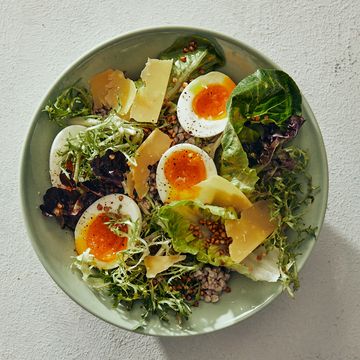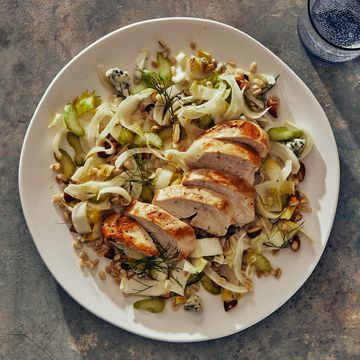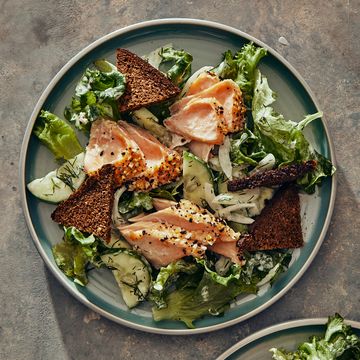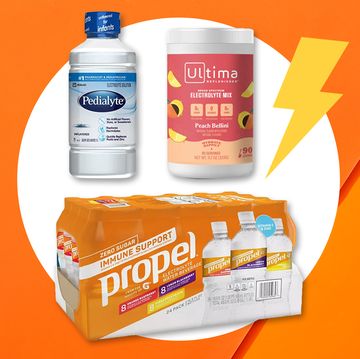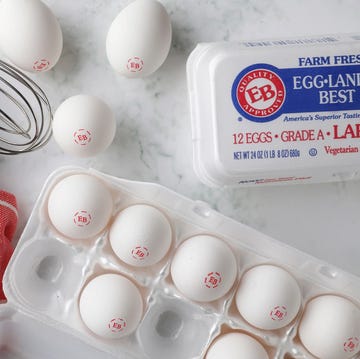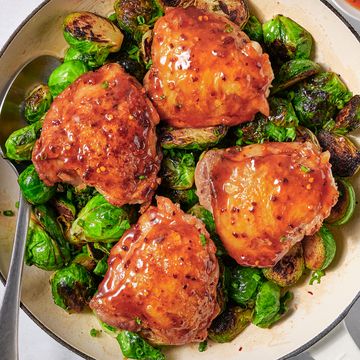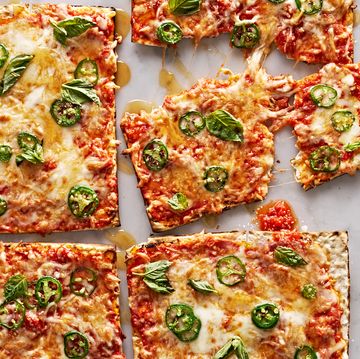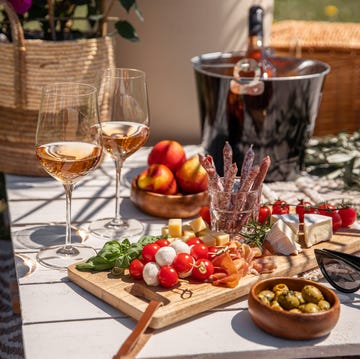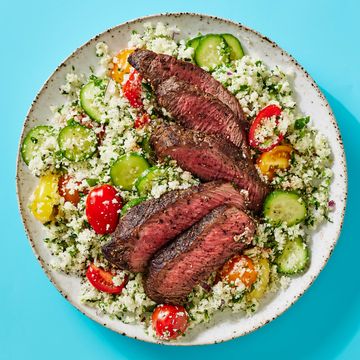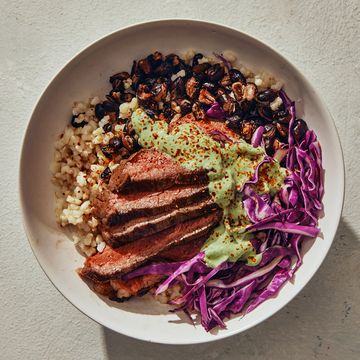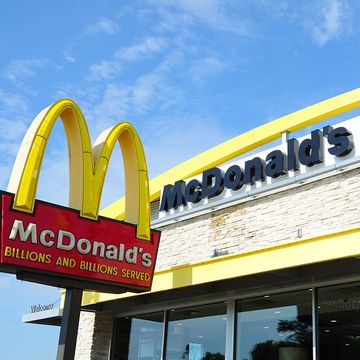While dietary guidelines and food pyramids certainly have their place, eating well is like assembling Ikea furniture: The simpler the instructions, the easier they are to follow. For example, consider the revolutionizing manifesto of food activist and author Michael Pollan: Eat food. Not too much. Mostly plants. In that vein, we asked our favorite experts—dietitians, nutrition Ph.D.s, top chefs, and food world authors—to share their personal commandments for eating healthfully, curtailing calories, cooking deliciously, and savoring every bite.
Pucker Up
"Lemon is my secret weapon," says Katie Lee, author of The Comfort Table. "Squeeze the juice or sprinkle zest over vegetables instead of using extra oil, butter, or salt. You can saute spinach with just a teaspoon of oil, and then add a little lemon juice for a lot of flavor without a lot of calories."
Taste the Rainbow
"I always ask 'Where are the colors?' when I look at a plate," says Ellie Krieger, R.D., host of Healthy Appetite on the Food Network and author of So Easy. "Ideally, there should be a full spectrum, since differently colored produce offers different antioxidants."
Embrace Your Inner Carnivore...
"If you compare lean grass-fed beef with skinless poultry breast, the fat is almost the same, but the beef gives you considerably more zinc, iron, and B12," says Catherine Friend, author of The Compassionate Carnivore. Bison and pasture-raised pork are also very lean, healthy, and delicious, she adds.
...And Your Hidden Vegetarian
"For the sake of your health and your waistline, vegetables should be the bulk of your meals, and there's almost nobody out there who couldn't benefit from eating more of them," says Mark Bittman, a food columnist for The New York Times and author of The Food Matters Cookbook. "Instead of a huge slab of some animal protein and a little side of veggies, do a small piece of fish or meat on a plateful of vegetables."
Sharpen Your Knives
A dull knife can lead to even duller food. "This is one of my most important rules," says WH contributor Cat Cora, the first female chef on Iron Chef America and author of Cat Cora's Classics with a Twist. "Cutting with sharp knives makes cooking more of a pleasure, and you'll be more likely to chop up lots of healthy veggies." Take your knives to a cookware or cutlery shop for a tuneup every few months.
Turn Off the Stove
That's right—shut down the heat a full three minutes before you think you should. "Overcooking removes flavor and nutrients," says food writer Merrill Stubbs, cofounder of Food52.com. "Internal heat keeps food cooking for a while after you remove it from the stove or oven, so let it sit a few minutes before serving."
Make Mother Nature Your Top Chef
"That means using organic sugar instead of sugar substitutes, fresh fruits and vegetables instead of processed foods," says Maria Rodale, author of Organic Manifesto: How Organic Farming Can Heal Our Planet, Feed the World, and Keep Us Safe and CEO of WH's parent company, Rodale. "If nature made it, it has to be better for you."
Think Before You Drink
"The average person consumes more than 400 calories a day from beverages," says Zinczenko. "And that includes about 10 teaspoons of added sugar from soft drinks." If you swap out juice and soda for no-cal drinks like unsweetened tea and water, you could lose up to 40 pounds in a year.
Stash a Snack
If you're carrying something that's healthy and portion controlled, you can satisfy the munchies without succumbing to a 500-calorie muffin. "I always pack light cheese, raw almonds, a packet of dry cereal, or a piece of fruit in my purse," says Cora.
Hew to Homemade
"Cooking is almost always healthier than eating restaurant or takeout food, and you're more likely to cook if you stick to a simple set of multipurpose tools," says Bittman.
Get the Flax
"Sprinkle ground flaxseed over cereal, pancakes, yogurt, smoothies, nut butters, and anything else you can," says Stephen Perrine, author of The New American Diet. "It's an easy way to add fiber and omega-3 fatty acids."
Have a Change of Seeds
Not a fan of flaxseed? Try pumpkin or sunflower seeds—two more great sources of healthy fats and some fiber, says WH contributor Keri Glassman, R.D., author of The O2 Diet.
Be an Egghead
"I always buy two dozen eggs, and boil one dozen to snack on," says Lee. Leslie Bonci, R.D., director of sports nutrition at the University of Pittsburgh Center for Sports Medicine, adds: "Eggs have only 70 calories and provide protein, vitamin D, iron, and sometimes omega-3s."
Whip Up Your Own Salad Dressing
Really, it's easier than getting the protective seal off a store-bought bottle. "Many premade dressings have water and high-fructose corn syrup as the primary ingredients," says Perrine, who makes his own dressing using oil, mustard, and balsamic vinegar or lime juice. The basic formula? Roughly three parts oil to one part vinegar, or half oil and half lime or lemon juice.
Raid Your Spice Rack
"Cinnamon may help regulate blood sugar, turmeric may help prevent Alzheimer's, and oregano may possess cancer-preventive properties," says Glassman. So sprinkle cinnamon on your latte, curry powder on your sauteed veggies, and big handfuls of herbs on salads and in pasta sauces.
Turn the Box Around
The front of any food product is where marketers stick claims like "natural," "low-fat," and "no added sugar"—all of which can mean squat. "The true test of the quality of the product is the ingredients list and the nutrition facts panel. Learn how to read those," says Jessica Seinfeld, author of the new book Double Delicious! Good, Simple Food for Busy, Complicated Lives.
Go with the Grains
"I make big batches of oatmeal, brown rice, and quinoa on the weekend and store them in the fridge," says Perrine. "When I need them for breakfast or side dishes during the week, I just heat them up in the microwave and they're ready to go."
Eat like it's Monday Morning
"Think of each meal as a clean slate, an individual opportunity to eat well," says Glassman. "If you've been eating a lot of fried foods or sweets, don't throw in the towel and have even more—you can start fresh the next time you sit down to eat."
Balance Your Meals, Balance Your Body
"The best options are meals and snacks that contain a mix of carbs, protein, and fat. This balance helps with satiety, weight management, blood sugar, and bone health," says Bonci. "So almonds and fruit are a better choice than pretzels, even if the calorie counts are the same."
Double Up on Apps Instead of Having One Entree
"Restaurant portions are usually huge, so my strategy is to order two appetizers: one salad or vegetable, and one protein-rich dish such as tuna tartare or grilled chicken skewers," says WH contributor Lisa Drayer, R.D., author of The Beauty Diet.
Relax, then Eat
"The whole world is not going to end if you take a break to eat," says Cora. It's better for your health, both physiological and psychological. "Have a glass of wine, and savor whomever you're with." (Alone? Savor the silence.)
Shake Up the Salt
"Good, flaky sea salt makes everything taste better," says food columnist Amanda Hesser, author of The Essential New York Times Cookbook. "It adds a crunchy texture and enhances the other flavors, and you can get away with using less of it."
Accept the Whole Food Pyramid
"Beware of any diet that eliminates an entire food group," says Jennifer Anderson, Ph.D., a professor of food science and human nutrition at Colorado State University. "Crazy rules like 'Eat fruit only in the morning' are just gimmicks for trying to sell a book."
Always Leave Wanting More
"Stop before you're full and while you still want to eat more," says Krieger. "Not in a negative, deprived way—you shouldn't still be hungry—but on a scale of 1 to 10, if 10 is Thanksgiving full and you usually eat until you're at an 8, try stopping at 6. You'll feel and look better."
Dine Without the Dictionary
"The FDA now has more than 3,000 ingredients on its list of safe food additives," says David Zinczenko, editorin-chief of Men's Health and author of the Eat This, Not That! book series. And because we don't really know how all those preservatives, artificial sweeteners and colorings, and flavor enhancers may affect your waistline and health, he suggests you follow this rule: If a 7-year-old can't pronounce it, you don't want to eat it.
Order the Weirdest Thing on the Menu
"Unusual foods tend to be healthier because they're raised or grown in nature or in small operations, not giant concentrated feedlots or massive, pesticide heavy farms," says Perrine. Think venison or rabbit instead of beef or pork; duck, ostrich, or pheasant instead of chicken or turkey; dandelion or watercress instead of Bibb or romaine; halibut or porgy instead of salmon or sea bass.
Rise and Dine
"Eat a breakfast that contains fiber with protein and a little fat, because it kick-starts your metabolism and fills you up until lunch," says Glassman. "My go-to meals: a slice of whole-wheat toast with natural peanut butter, or a scrambled egg with some berries." Bonus: Research shows eating breakfast may help you lose weight and keep it off.


